You draw in a chest full of air and try to let it slowly out as you hear your heart thumping in your ears. You place your hand on the doorknob. You’re ready – or at least as ready as you’re going to be. You know there are threats on the other side of that door. You know there are also non-threats that must be avoided. You get the “go” signal, and your hand turns the knob and opens the door, while you draw your pistol and simultaneously push the gun out to a level sight picture – carefully scanning around the first corner. The first threat lurks just beyond the entry to your left – and takes your first two rounds dead center. You move around the corner to find another threat, this one hiding behind a hostage, only partially accessible. You put a well-aimed shot into the threat. You are hyper-focused on your front sight and watch it rise with the recoil of the gun and then fall back on target in a fraction of an instant, and place your second shot on target. On it goes, until you have engaged and neutralized half-dozen or more threats. Suddenly your focus changes as you hear the voice of the safety officer giving you the instructions to show a clear gun and holster.
You’ve just shot the first stage of today’s IDPA match, and there are several more stages to go. Sound like fun?
Welcome to the International Defensive Pistol Association – IDPA.
On any given weekend, all across America and in several other countries around the world, scenarios like the one described above play out over and over for thousands of IDPA members in local clubs and major matches. IDPA is an interesting blend of competition, recreation, and training. I’ll qualify what I mean by “training” in a bit. There is a great deal that can be said about IDPA in terms of history and purpose, but this article is about how to get started – so I’m going to cut to the chase and skip most of that. Suffice to say that IDPA was founded on the principle that there should be a shooting sport that remained true to the “real world scenario” and more importantly, used “real world guns and equipment”. The latter is the key to best understanding IDPA. The equipment rules of IDPA are strict about the types of guns that can be used in the sport. There are also some pretty strict rules for holsters, belts, magazine carriers, and cover garments. The basic concept is simply this: Using a gun that you might really carry for self-defense, in a holster that you might really carry it in, and concealed by a cover garment as would be required for civilian or off duty concealed carry – shoot a scenario-based course of fire under artificial stressors like the timer and peer pressure.
To get started in IDPA….
You first need to understand some of the high level categories of the sport, because this can affect your decision on guns and related equipment. There are five categories for the guns themselves: Stock Service Pistol (SSP); Enhanced Service Pistol (ESP); Custom Defensive Pistol (CDP); Stock Service Revolver (SSR); and Enhanced Service Revolver (ESR). As you can see, there are pistols (semi-automatic) and revolvers, each separated into stock and enhanced. Stock basically means what it implies – out of the box condition with only slight changes allowed – all of which must be manufacturer parts. Enhanced allows more changes to be made, such as after-market triggers, flared magazine wells and the like, but still within fairly strict limitations. That oddball group called CDP is basically the 1911 category (though most any .45 Auto can be used). IDPA requires a minimum of 9mm caliber (.38 Special for revolvers) and there are power factor requirements to ensure “extra light” loads are not used for an unfair advantage and to “keep it real”.
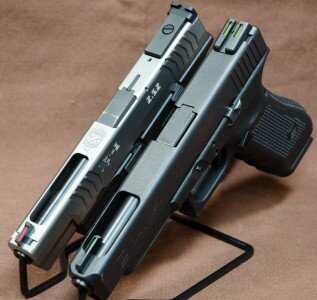
Many leading gun makers offer very similar ‘competition models’. These are very popular among IDPA shooters.
Shooters too, are divided into categories – or classes based on their skill level. These classes are: Novice; Marksman; Sharpshooter; Expert; and Master. It is possible (even common) for an individual to hold multiple classifications, because the classification is tied to the category of the gun you used to earn it. In other words, you can be a Sharpshooter in SSP and a Marksman in SSR. There are a few individuals who have achieved the level of Master in all five gun categories. The first person to accomplish this was long-time gun author and self-defense expert, Massad Ayoob. You won’t see my name ever appear on that list. I am just good enough at it to have a sense of reverence for those who reach the mountain top.
In just the past few years, IDPA has seen a huge surge in participation and membership. I asked IDPA’s Executive Director, Joyce Wilson, what she thought about the up swell. Joyce offered the following comment: “The record breaking sales of firearms the last couple of years has definitely had a positive impact on IDPA. We have seen tremendous growth in the sport as these new firearms owners desire to learn more about their weapons than just lining up the sights. IDPA is the perfect shooting sport for new owners that are interested in concealed carry as that exactly why the sport was developed. The whole premise of IDPA scenarios is based on what could happen at any point in our lives. From home invasion scenarios to car jackings, our courses of fire are based on real life situations.”
This makes a good spot to segue back to the “training” issue as it relates to the sport. First and foremost IDPA is a game. If you have a rule book, a score sheet, and people go for pizza after – you’re playing a game. Now, that said – there are absolutely elements of training benefit to shooting IDPA. In my opinion, much more so than with other shooting sports. The experts can express it better:
“Although IDPA expressly describes itself as a sport and not a training function, I compete in IDPA in part because it does indeed have a training element. The competition is a relevant skill test of drawing and reloading from concealment, getting to and effectively deploying behind cover, and hitting what you’re shooting at under pressure and at speed. Testing skills is absolutely a component of training.” — Mas Ayoob
“While we don’t ‘train’ individuals, we provide an avenue for them to practice gun handling skills that could potentially save their lives. Doing this under time pressure helps give them the adrenaline rush similar to what they may experience in a situation.” – Joyce Wilson
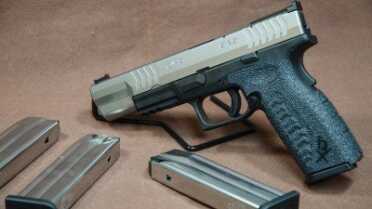
Also enormously popular, the Springfield Armory XD-M 5.25 (shown in 9mm) also comes with a holster and mag carrier.
I agree, and I can tell you that I can draw from concealment and make accurate hits faster, more safely, and under more stress, than I ever could without the sport of IDPA. So, you want to get started shooting in IDPA? A fellow IDPA member put it very well when he said that you really have to separate it into two parts: Hardware (guns, holster, ammo, clothing) and Software (knowledge, mindset, training, etc.). That is a great way to approach it, so I am going to steal that concept and use it here.
Hardware – Guns, Ammo, Holsters, Gear
The hardware is actually the easy part, but it is the part that most of us obsess on and spend the most time fretting over. It is also the first place most people try to make a change in order to improve their skill. As with most any sport, trying to increase your skill level with “things” almost never works. Think of golf – if you have Tiger Wood’s clubs you’re not going to achieve his score. Similarly, if you have Bob Vogel’s gun you’re not going to achieve his score either. But that doesn’t mean that it isn’t very important to select good hardware that gives you the best opportunity to succeed. Let’s visit some of the things you’ll need.
You should put the most thought into which gun you want to start with. It is the most expensive piece of equipment and most of your other hardware will be related to it, so make this decision first. Do you carry a concealed firearm for self-defense? If yes, then you may wish to have a competition gun that is very similar to your carry gun. Some shooters use the exact same gun they carry. This is practical if your carry gun has sufficient capacity (10 rounds or more in the magazine for most semi-autos) and is big enough to give you a good sight picture and not beat you to death with recoil (remember, a match can be a couple hundred rounds within a few hours).
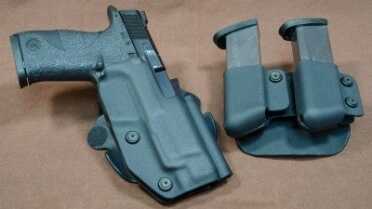
A Comp-Tac matched set holster and mag carrier for the Smith & Wesson M&P. Both are paddle design, the author’s preference.
Many law enforcement officers who play the game will use their duty weapon and all the standard gear. Most people take some liberties with the “same as you’d carry” philosophy – including me. Nearly every major gun maker has their “competition line” now, and IDPA is a huge factor in their design. These pistols usually have a 5” barrel, high magazine capacity, special sights (fiber optics are hugely popular), etc. To name just a few are: Glock models 34/35; Smith & Wesson M&P Pro Series; Springfield Armory XDM; and Walther PPQ 5”. The most common caliber is 9mm, but most are also available in .40 S&W. IDPA has a special box into which your gun must fit (with the lid fully closed) or it is not legal.
It’s no coincidence how perfectly the guns named above fit into that box! My advice is to try to use what you have. If you have a Glock 19 that you carry – use it. Once you become addicted to the sport (oh, and you will) you can upgrade to a designated “match gun”. You’ll make a much smarter decision when using your own experience. But basically, my advice is to select a gun that you feel you shoot well, for which ammunition is readily available, that you feel will be reliable to shoot a couple hundred rounds in conditions you can’t control.
Holster and Mag Carrier
Next to the gun itself, the most important equipment is the holster. Holsters are a subject unto themselves, so I won’t go down the road of good-better-best here. My advice is to buy a holster that is specifically made for your gun – not just one that “pretty much fits”. Kydex and similar polymer materials are very popular and generally inexpensive.
Expect to pay between $60 and $90 for a well-made plastic holster that is made for this purpose. Be sure the holster is IDPA legal – there are restrictions on the amount of offset and drop a holster may have, as well as how much of the gun can be exposed when holstered. Most major brands of holsters will state “IDPA Legal” or not, and if unsure you should ask them. IDPA does not sanction specific holsters, so there is no official list. Same goes for the magazine pouch. Your magazine carrier should fit your magazines properly. They should be snug and capable of being tipped upside down fully loaded without falling out. Most holster companies have a matched set available for sale, and those are often a good way to go. The next question is belt loops versus paddle. I like paddle holsters for IDPA. Easy on, easy off. Easier to make fine adjustments to position. For me, they stay in place better too. A holster that is held with belt loops can wander forward or backward and can also droop more than a good paddle holster.
Be sure your holster and mag carriers are adjusted properly to hold the right tension on the important contents they carry. A dropped magazine during a stage is costly – either in time or penalty. A dropped gun can be immediate disqualification. I also find that I get a better grip if my holster requires some effort on my part. It helps avoid the fumbling that can occur if you aren’t required to have a firm grip to get the gun out of the holster. I also like to ensure that my unloaded gun can be held upside down in the holster without falling out.
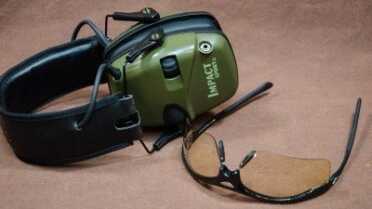
Active electronic earmuffs are highly recommended, as is good quality eye protection. These eye protectors have transition lenses that darken automatically in bright daylight.
Other Gear and Accessories
Aside from the gun, magazines, and holster/carrier for them you need a good quality belt to hang them from. Good leather is always nice. Many shooters like the nylon web style. I have come to like them due to durability and fine-adjustment capabilities. The belt should be strong and stiff enough to be a firm support platform for the gun and the loaded magazines. It also needs to fit the pants you plan to wear – and if you’re using a belt loop mounted holster – be sure they are compatible!
Eye and ear protection. Here is a place I urge you to splurge. You only get one pair of each of these, and protecting them is very important. Hearing damage is cumulative over your lifetime, so you can’t over-protect your hearing. I strongly recommend the active over-the-ear muff style protectors. They are designed to amplify common sounds so that you can clearly hear range commands and other’s speaking – but they cut out the harmful noises above certain decibel levels. They are electronic, so spare batteries are a good idea. Eye protection should wrap around the side of your face enough to protect your eyes from harm when your head might be turned 90 degrees from shrapnel coming off a steel target or similar. Be sure they are properly impact rated. You can spend big bucks, or still get quality (with less fashion perhaps) by going to your home improvement store and getting a pair… your choice.

A stage bag with separators and magazine pockets is desirable. This one also includes a pouch for your empty casings.
Anything else you invest in is optional – though several things are going to feel like necessities. The first of these is a good range bag. At our local IDPA matches, we shoot between 5 and 7 stages routinely. The ammo you have to carry alone will be cumbersome.
You’re also going to need extra magazines (3 are required, and I feel like I’m in trouble if I don’t have at least 4). Magazine loaders are a God send, and soon you’ll find one a must have. Eye and ear protection, when you’re not wearing it, has to go somewhere. Water, a snack, sunscreen… you get the picture. You will ultimately want to invest in a good range bag. I like one that is offered by MidwayUSA that has a removable stage bag and tons of storage. It is less expensive than many inferior bags. You don’t have to buy the most expensive gear – and I would recommend waiting until you’ve visited a match once or twice and get tips from the other shooters.
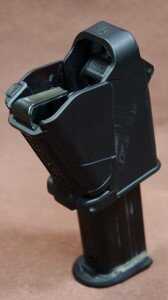
A magazine loading tool, such as this UpLula model will quickly become essential equipment. Like any sport, there is no shortage of ways to spend your money!
Software (Safety, Skills, Mindset)
What you can’t buy at the local gun store or online outfitter is the software. I’m borrowing that terminology from my friend and frequent squad mate, Stephen – U.S.M.C, Federal law enforcement agent, and extremely fine shooter. When he offers advice, I get out my pencil. To continue the golf analogy, I can walk out of the pro shop with everything I need to play golf – except for all the important things I need – which I can’t buy in the store. Same with the shooting sports like IDPA, with one huge addition – safety. You don’t need a nanny lecture and you’re not going to get one, but you won’t last long at any shooting match of any kind if you don’t understand and follow all the safety rules. This is the one area where we all lose our sense of humor – and for good reason. Few sports are as potentially dangerous to participant and spectator alike as shooting sports, and it wouldn’t take many incidents to shut the sport down – especially in today’s climate. So, while I’ll end the lecture about safety here, understand that it is first and foremost at all times, and that IDPA has an excellent safety record!
Having said that, in all other ways you should try to focus on fun and not take things so seriously. You will perform better, learn better, and have a much better experience if you roll with it. You’ll find a lot of support and helpful people around you. There is a camaraderie among IDPA members that is as good as any I’ve experienced.
Your skills are going to take time to build. Don’t try to rush yourself, and don’t try to shoot faster than you can hit your target. Don’t try to draw your gun or perform reloads faster than you’re comfortable doing it. The saying “slow is smooth, and smooth is fast” is true.
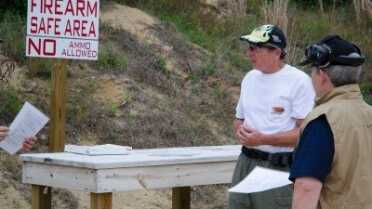
Local Match Director, Chuck Limpert gives new shooters a safety and rules orientation. Note that there is a designated area for safe firearm handling.
Going to your first match
Getting started is easy – just find a club in your area. Simply go to www.idpa.com and use the search for a club tool to find the one closest to you. You’ll find contact information there, and often directions are provided too. I recommend contacting the match director or other contact provided, and let them know you are interested in IDPA and that it would be your first time. I have never met a match director that wouldn’t welcome newcomers with open arms. They will give you any extra information you might need, such as what to bring with you and who to ask for when you arrive. A new shooter briefing is customary, and here you will be instructed about the safety rules and many of the basic IDPA match rules.
A lot of newcomers to any sport are intimidated and apprehensive. Everyone else seems to know each other, they are probably all insanely skilled shooters, and I’m going to feel stupid. Sound familiar? That’s how I felt, and most likely how everyone feels when they go to their first match. But I assure you, you will find a warm and welcoming environment, and your first question at the end of it will be “when is the next match!?”. I would like to acknowledge here, the many good friends I have made in IDPA, and the comments, thoughts, and suggestions given to me about what to include in this article. In the end, much like golfing, sailing, or fishing – the activity might draw us in but the camaraderie keeps us coming back.
I’ll leave you with some parting words from Joyce Wilson, Executive Director of IDPA:
“Most importantly, it’s fun and a way for likeminded shooters to get together. IDPA is extremely new shooter friendly and most clubs have a new shooter orientation program to introduce people to the sport. Many clubs now are also developing ‘women only’ shooter orientations so that hopefully we can make it less intimidating for new female shooters. At Headquarters we are also looking for more ways to encourage more women into the sport. We feel that it is important for continuing our Second Amendment rights as well as helping women realize that they can protect themselves.”

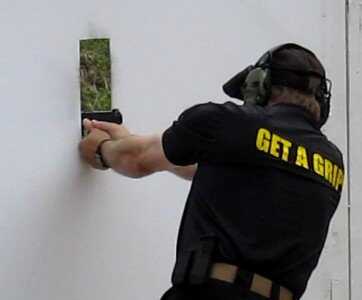
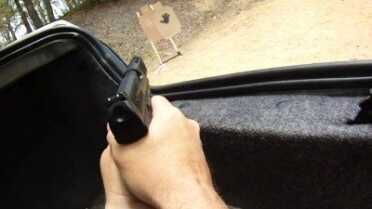
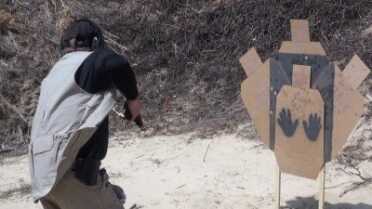
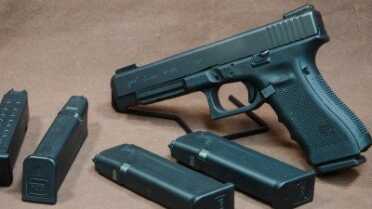
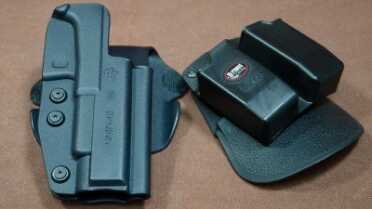
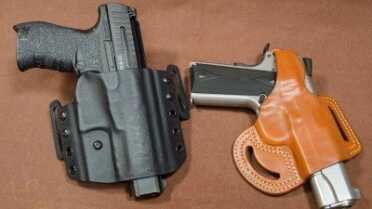
Just as someone commented: first time I got a lot of procedurals, but stayed in the game. Two years now; learning and having fun. Great training also…
Been hooked for 3 years. Would strongly recommend taking an introduction class at a qualified facility. I knew nothing about the sport when I took my class at the Scarborough Rod & Gun here in Maine. Two days well spent and a classifier to boot. So many rules and a lot to sort out as a new to competition shooter. ( Down what??) A class can go a long way in putting it all into perspective. Everyone is so eager to help and we are all in it for just plain FUN! Now to try a State match….
I can personally attest to both the initial intimidation and the warm welcome that you encounter the first match you participate in. I went in with no intent to place, but with the goal of not getting any safety violations and hitting no friendly targets. I placed dead last in my class, but accomplished both goals. Overall, a wonderful experience.
will protect live stock or whatever you want cheep